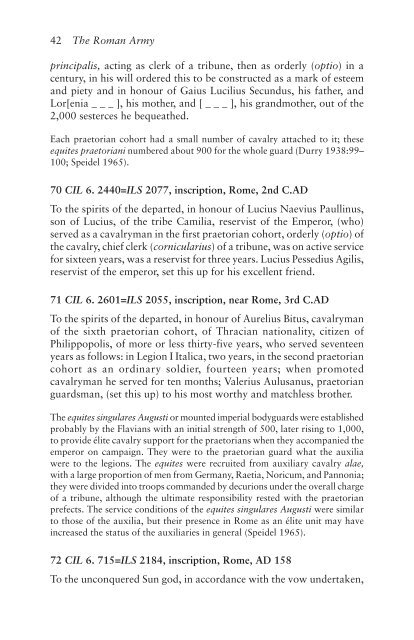The Roman Army, 31 BC–AD 337: A Sourcebook
The Roman Army, 31 BC–AD 337: A Sourcebook
The Roman Army, 31 BC–AD 337: A Sourcebook
Create successful ePaper yourself
Turn your PDF publications into a flip-book with our unique Google optimized e-Paper software.
42 <strong>The</strong> <strong>Roman</strong> <strong>Army</strong><br />
principalis, acting as clerk of a tribune, then as orderly (optio) in a<br />
century, in his will ordered this to be constructed as a mark of esteem<br />
and piety and in honour of Gaius Lucilius Secundus, his father, and<br />
Lor[enia _ _ _ ], his mother, and [ _ _ _ ], his grandmother, out of the<br />
2,000 sesterces he bequeathed.<br />
Each praetorian cohort had a small number of cavalry attached to it; these<br />
equites praetoriani numbered about 900 for the whole guard (Durry 1938:99–<br />
100; Speidel 1965).<br />
70 CIL 6. 2440=ILS 2077, inscription, Rome, 2nd C.AD<br />
To the spirits of the departed, in honour of Lucius Naevius Paullinus,<br />
son of Lucius, of the tribe Camilia, reservist of the Emperor, (who)<br />
served as a cavalryman in the first praetorian cohort, orderly (optio) of<br />
the cavalry, chief clerk (cornicularius) of a tribune, was on active service<br />
for sixteen years, was a reservist for three years. Lucius Pessedius Agilis,<br />
reservist of the emperor, set this up for his excellent friend.<br />
71 CIL 6. 2601=ILS 2055, inscription, near Rome, 3rd C.AD<br />
To the spirits of the departed, in honour of Aurelius Bitus, cavalryman<br />
of the sixth praetorian cohort, of Thracian nationality, citizen of<br />
Philippopolis, of more or less thirty-five years, who served seventeen<br />
years as follows: in Legion I Italica, two years, in the second praetorian<br />
cohort as an ordinary soldier, fourteen years; when promoted<br />
cavalryman he served for ten months; Valerius Aulusanus, praetorian<br />
guardsman, (set this up) to his most worthy and matchless brother.<br />
<strong>The</strong> equites singulares Augusti or mounted imperial bodyguards were established<br />
probably by the Flavians with an initial strength of 500, later rising to 1,000,<br />
to provide élite cavalry support for the praetorians when they accompanied the<br />
emperor on campaign. <strong>The</strong>y were to the praetorian guard what the auxilia<br />
were to the legions. <strong>The</strong> equites were recruited from auxiliary cavalry alae,<br />
with a large proportion of men from Germany, Raetia, Noricum, and Pannonia;<br />
they were divided into troops commanded by decurions under the overall charge<br />
of a tribune, although the ultimate responsibility rested with the praetorian<br />
prefects. <strong>The</strong> service conditions of the equites singulares Augusti were similar<br />
to those of the auxilia, but their presence in Rome as an élite unit may have<br />
increased the status of the auxiliaries in general (Speidel 1965).<br />
72 CIL 6. 715=ILS 2184, inscription, Rome, AD 158<br />
To the unconquered Sun god, in accordance with the vow undertaken,



